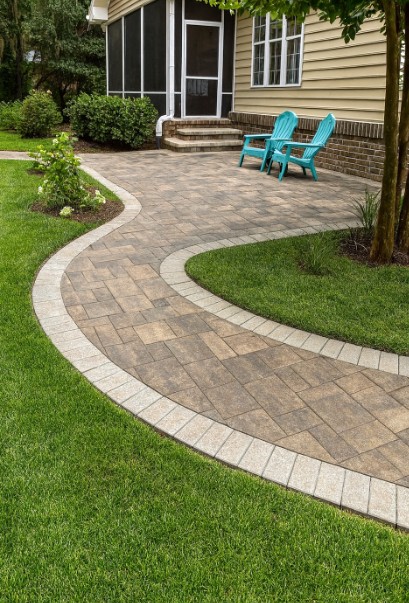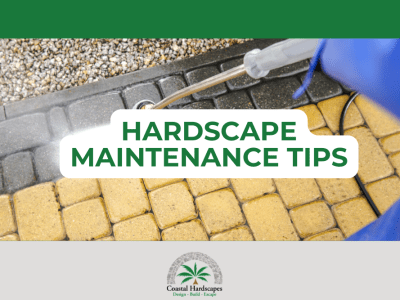Are you looking for the best hardscape maintenance tips to ensure your patio, walkway, or porch stays in great shape?
If so, the team here at Coastal Hardscapes of Coastal Georgia has you covered! In this guide, we will walk you through the proper maintenance tips for hardscaping based on the materials and best practices!
7 Hardscape Maintenance Tips
Your patio faces rain, sun, foot traffic, and the occasional dropped drink. Without proper care, even high-quality pavers can develop cracks, stains, and weeds sooner than expected. This guide gives you the know-how to keep outdoor spaces strong and beautiful season after season. The last section might change how you plan your spring cleanups.
1. Cleaning Patio Pavers

A clean patio does more than look nice; it helps protect your investment. Dirt, moss, and algae don’t just stain the surface; they slowly erode joints and create slippery spots. By sticking to a proper routine, you maintain both beauty and safety.
Here’s a simple checklist you can follow to keep your patio or paver walkway clean:
- Sweep (or use a blower) the surface weekly with a stiff broom to prevent soil and leaves from compacting.
- Pull or brush away weeds before they root deeper into sand joints.
- Hose down the area monthly to wash off loose dirt and pollen.
- Spot clean stains promptly with mild detergent and a nylon brush (softly).
- Use a pressure washer only on low to medium settings to avoid blasting out sand.
- Rinse thoroughly and let the area dry before adding joint sand or sealer.
2. The Best Cleaning Methods for Outdoor Hardscape Surfaces
It is absolutely vital that you clean with caution, as silly as that may sound. Believe it or not, pavers and even concrete can be easily damaged if you don’t use proper cleaning techniques (too much pressure).
Excessive pressure from a pressure washer can damage the stone, while the wrong chemicals can harm nearby plants and even compromise the structural integrity of your hardscape (Are you scared yet?).
Don’t worry, for the best results come from pairing the right method with the right surface.
Here is what we recommend for cleaning your hardscapes:
| Method | How It Works | Best For | Caution to Keep in Mind |
|---|---|---|---|
| Sweeping & Brushing | Avoid harsh detergents that strip the sealer. | Pavers, walkways, patios | Needs consistency; won’t remove set-in stains. |
| Soap-and-Water Wash | A stiff-bristle broom lifts loose dirt and leaves. | Most masonry, light stains | Avoid harsh detergents that strip the sealer. |
| Eco-Friendly Cleaners | Oxygen bleach lifts organic stains safely. | Shaded patios, moss, mildew | Avoid harsh detergents that strip the ealer. |
| Pressure Washing | Low to medium setting rinses off grime. | Driveways, heavily soiled areas | High pressure can dislodge sand and etch stone. |
3. How to Remove Moss, Algae, and Organic Stains from Patios:

In our opinion, especially in the Savannah and Hilton Head coastal regions, the moss and algae is the biggest issue for hardscaping. Because of the humidity, the ability for algae and moss spores to grow is ideal. Factor in shade, and you have the perfect growth base, it just so happens to be on top of your beautiful patio.
A client once asked if the green on their pavers meant their patio had “gone eco-friendly.” Not exactly.
That moss and algae might look natural, but they trap moisture, create slick spots, and degrade surface integrity over time. You read that correctly, these organic stains and buildups can reak havoc! These stains spread fastest in shady, damp areas, especially after spring rains or humid summers (sounds like Savannah, right?).
Start with the basics:
- Rake away leaves and surface debris to stop spores from settling.
- Mix a 1:1 vinegar-to-water solution and spray the affected area. Let it sit for 30–60 minutes before scrubbing gently with a soft-bristle brush.
- For stubborn stains, apply a specialized patio cleaner containing sodium percarbonate—a safer alternative to bleach that lifts organic buildup without harming surrounding plants.
- Rinse thoroughly, let dry fully, and reapply joint sand if needed.
4. Patio Sealing
Should you seal your patio? This is always a question we struggle to answer because it really depends on a few factors.
Sealing applies a protective layer that repels water, inhibits stain absorption, and enhances color vibrancy. By reducing moisture infiltration and UV damage, sealers extend paver lifespan and simplify future cleaning. However, it also needs to be done correctly, and you want to make sure it is compatible with your paver or hardscape material.
For patio sealing here is what we recommend:
| Sealer Type | Advantage | Mechanism |
|---|---|---|
| Acrylic | Enhances color and sheen | Forms a UV-resistant film |
| Penetrating (Silane/Siloxane) | Repels water, breathable | Bonds within pores to block moisture |
| Polyurethane | Chemical resistance | Creates a durable, impermeable layer |
These sealer options shield pavers from oil stains, moss growth, and freeze–thaw effects, promoting long-term performance.
5. Removing Hardscape Stains
How do you remove oil, rust, and other common patio stains?
Choosing the right treatment protects paver integrity and prevents etching, so how do you not only choose the right stain remover, but then apply it correctly? Different stains call for tailored solutions:
- Oil: Apply an absorbent clay-based poultice, let it sit, then sweep away residue.
- Rust: Use a phosphoric-acid rust remover per product instructions, then rinse.
- Organic (leaf, food): Scrub with an enzyme cleaner to break down proteins.
When tackling tough fireplace or patio stains, choosing the right cleaning method makes all the difference. Each tool or product serves a specific purpose—some lift oil and grease, while others target rust, soot, or organic buildup. The guide below outlines four effective stain removal options and how to use them safely and efficiently. Always test a small area first to ensure compatibility with your stone or paver surface.
A well-equipped maintenance kit contains essential instruments and supplies:
| Tool/Agent | Purpose | Usage Tip |
|---|---|---|
| Stiff-Bristle Brush | Dislodge dried-on debris | Scrub in circular motions |
| Clay Poultice | Absorb and lift oil residues | Cover stain fully and dry overnight |
| Phosphoric Rust Remover | Dissolve iron oxide deposits | Rinse promptly after reaction |
| Enzyme Cleaner | Breakdown organic matter | Allow 10–15 minutes before scrubbing |
Having these items on hand ensures a rapid response to new stains and keeps your patio pristine.
6. Caring for Fire Pits and Outdoor Fireplaces
“Winter is coming” made great television because of fire and ice, not because the fire pits cleaned themselves. Real life needs upkeep. Ash absorbs moisture, creates lye, and slowly corrodes metal and mortar. Safe heat and long life come from specific inspections and cleanings performed on a set cadence.
- After each use: remove cool ash with a metal scoop and store it in a lidded bucket.
- Monthly: brush soot from firebrick and check for hairline cracks or loose caps.
- Each season: verify clearances, inspect the cap and spark screen, and confirm joints are intact.
Avoid accelerants. Rapid flare-ups stress masonry and discolor pavers. If wood is damp, let it season; wet fuel smokes, stains, and shortens chimney life. Gas units need the same care: keep burner ports clear, test the shutoff, and watch for soot that signals incomplete combustion.
7. Maintaining Paver Walkways and Driveways

A cracked slab screams for attention. Pavers? They whisper when something’s off, until the driveway dips or a row lifts like loose teeth.
Unlike concrete, with pavers, you don’t replace the whole thing/section. You can simply replace the specific paver stone/brick that has an issue. That is the upside to a paver vs concrete debate: pavers are customizable and easier to maintain. But the real key is to stay ahead of the wear.
- Watch for shifting: One corner rising? One tire rut deepening? Water is moving under the surface. Lift, reset, and recompact before it spreads.
- Joint sand matters: Ants love soft joints. So do weeds. If the sand looks low, top it up with polymeric sand and mist it in.
- Keep the edges tight: No edge restraint? You’ll get “paver creep.” That’s when your walkway slowly unravels like a loose thread.
- Treat stains fast: Oil, rust, tire marks—they set in fast under Southern heat. Use paver-safe cleaners and rinse thoroughly.
- Snow season prep: If you use shovels, choose plastic or rubber edges only. One bad scrape and you’re left with scars that hold water and age the surface.
Bonus: Hardscape Seasonal Maintenance Checklist
Want to simplify this entire process with a screenshot? Just take a screenshot of this simple annual hardware maintenance tip calendar below!
Weather doesn’t keep a calendar. Your patio should. With Georgia’s year-round swings, seasonal care makes the difference between “still looks great” and “when did this fall apart?”
Spring
✅ Remove winter buildup (leaves, algae, grime)
✅ Inspect for frost heave or lifted pavers
✅ Rinse surfaces and sweep in new joint sand if needed
Summer
✅ Check irrigation and drainage—overwatering shifts base layers
✅ Spot clean stains from grills, foot traffic, and sunscreen spills
✅ Consider resealing if the color looks faded or the surface feels porous
Fall
✅ Clear leaves often—wet piles will stain
✅ Inspect fire pits and lighting systems before cold nights
✅ Look for sinking near high-use areas
Winter
✅ Avoid salt or de-icers unless labeled paver-safe
✅ Use snow shovels with rubber edges only
✅ Watch runoff patterns to prevent pooling near edges
Professional Hardscape Maintenance vs. DIY
We get this question often: “Can I maintain my own hardscape, or should I pay someone?”
It is a loaded question with a somewhat complex answer. If you’ve ever tried to pressure wash a stain only to make it worse, you’ve met the limits of DIY. Some tasks are weekend-worthy.
Others?
Not so much. Knowing the difference protects your investment, which is why we generally say cosmetic things like weeds, blowing of your patio, and things like that are easy DIY. However, sealing, removing stains, and structural adjustments should be left to the professionals.
You can use the table below to guide you:
| Task | DIY Friendly? | Professional Recommended When… |
|---|---|---|
| Stains are deep, acidic, or touch-sealed areas | Easy & effective | — |
| Joint sand top-up | With proper tools | Pavers have shifted or sand keeps washing out |
| Stain removal | Depends on type of stain | Pavers have shifted, or sand keeps washing out |
| Power washing | Risk of damage | Joints blow out, efflorescence appears |
| Sealing | Requires skill | Surface streaks, peeling, or uneven drying occur |
| Paver reset or regrading | The base layer is compromised, or the edge restraint fails | The base layer is compromised or the edge restraint fails |
The Final Word on Hardscape Maintenance –
Maintenance is required for everything. Your home’s roof, its siding, the foundation, your water heater, you name it, they all require maintenance. Some maintenance is annual, and some home maintenance is monthly.
Your hardscape areas around your home or business are not immune to maintenance; however, the more routine you are, the less you will have to do in the long run, and the longer your patio or walkway will last!
Take these practical tips into consideration if you’re the proud owner of a hardscape area; they will be sure to serve you well! Lastly, contact us today for an inspection or tailored service plan if you are in the Savannah, Pooler, or Richmond Hill area.
We’ll protect your hardscape from stains, shifting, and costly repairs because it’s cheaper to call us now… than to rebuild later!
Frequently Asked Questions
1. How much does maintenance usually cost for a paver patio or pergola in Savannah Quarters?
Maintenance costs for hardscaping are typically minimal compared to other outdoor materials, such as wood. Most Savannah area homeowners spend between $200 and $500 per year, depending on patio size, cleaning frequency, and whether they choose to reseal the surface.
Coastal Hardscapes designs every project for long-term durability, so regular sweeping, seasonal rinsing, and a professional sealant refresh every few years are usually all that’s needed to keep it looking new.
2. Can you pressure wash pavers without damaging them?
Pavers can absolutely be pressure-washed (but it has to be done correctly). Still, it’s essential to use the proper nozzle, distance, and pressure settings to avoid etching the surface or dislodging polymeric sand between joints. Coastal Hardscapes recommends a low-pressure rinse or hiring a professional who understands how to clean sealed pavers safely. This helps maintain the integrity of the joint sand and the protective finish.
3. How long do paver patios and pergolas last in coastal Georgia’s climate?
When properly installed and maintained, paver patios can last 30 years or more, and a quality-built wooden pergola can exceed 15 to 20 years with routine sealing and care. Our installations are engineered for Savannah’s humidity, salt air, and shifting soils—ensuring your outdoor space stays beautiful and structurally sound for decades.
4. What Are Effective Methods for Firepit Stain Removal?
Do you need to remove stains from your fire pit? To remove soot and stains without damaging your stone or brick, start gently and work up as needed:
- Dry Clean First: Use a dry soot sponge or vacuum with a brush attachment to lift loose debris.
- Mild Wash: Mix dish soap with warm water, scrub with a nylon brush, rinse, and let dry.
- Tough Soot or Creosote: Use a masonry-safe fireplace cleaner; follow directions, scrub lightly, rinse, and dry.
- Rust Stains: Apply a rust remover or oxalic acid poultice, let sit 1–2 hours, then rinse thoroughly.
- Grease or Food Marks: Blot fresh spills, apply a baking soda paste or oil stain poultice, dry, and scrape clean.
- Efflorescence (White Powder): Brush off salts when dry and rinse with clean water; avoid acid cleaners on soft stone.
- Safety First: Protect plants and nearby surfaces, wear gloves and eye protection, and use low-pressure rinsing only.
5. When and How Often Should You Seal Your Patio?
For most materials, a fresh seal every 2–3 years is ideal. After thorough cleaning and complete drying:
- Apply sealer in thin, even coats with a low-nap roller.
- Allow 24–48 hours of cure time before foot traffic.


 Westbrook (Savannah Quarters) New Patio & Pergola
Westbrook (Savannah Quarters) New Patio & Pergola